|
|
Newsletter September 2020 | Menu of Newsletters

The Moulé Group, at the University
of California/Davis, is interested in the solution processing and patterning of
organic electronic materials for use in devices such as light-emitting diodes,
photovoltaics, transistors, thermoelectric, and chemical sensors. The Group
specifically focuses on using structural and dynamic measurement techniques to
quantify the effects of solution processing and patterning on material
morphology and device architecture.
Tucker Murrey, a doctoral candidate
and published author with the Moulé Group, is actively involved with
researching and designing a scalable optical patterning process for organic
photovoltaic applications.
"Most working organic devices consist of
several layers of material, each having a specific optical and/or electronic
function," said Murrey. "One universal design constraint for complicated device
architectures, like organic field-effect transistors (OFETs), organic
photovoltaics (OPVs) and red-green-blue organic light-emitting diode (OLED)
displays is that they require multiple components patterned laterally and
vertically to operate. Currently, many of these components are comprised of
non-flexible inorganic materials. In order to move towards flexible, all
organic electronic devices, there is a need to develop high precision vertical
and lateral patterning methods that are compatible with solution processing.
mmense efforts in the plastic electronics field have led to
unprecedented progress and continuous improvements in organic photovoltaic
(OPV) performance.
"Given that conventional photolithography technology
techniques are incompatible with polymeric semiconductors, there is a critical
need to develop scalable photopatterning methods capable of laterally
patterning organic semiconducting compounds with sub-micromometer resolution,"
added Murrey. "This patterning process would enable the construction of a
sophisticated OPV architecture designed to increase external quantum
efficiency."
"A scalable process for controlling film topography with
sub-micrometer resolution would represent a substantial development that
enables the advancement of complex organic electronic device architectures,"
continued Murrey.
Photothermal Projection Lithography
The
Moulé Group is working on a series of solution-based methods, one of
which is called Photothermal Projection Lithography for Polymeric
Semiconductors with Sub-diffraction Limited Resolution.
Polymeric
semiconductors combine many of the electrical properties of inorganic
semiconductors with the mechanical flexibility and chemical processability of
organic materials, such as enabling them to be deposited from solution over
large areas, greatly reducing production costs compared to conventional
metallic semiconductors. Developments like this have motivated a rapid increase
in demand for low-cost, high-throughput, and high-resolution fabrication
techniques.
Organic semiconductors are non-metallic materials that
exhibit semiconductor properties, whose building blocks are polymers made up of
carbon and hydrogen atoms. These conductive polymers are, essentially,
electrical insulators, but become conducting when charges are either injected
from electrodes or by photoexcitation, or doping the intentional introduction
of impurities into an intrinsic semiconductor for the purpose of modulating its
electrical, optical, and structural properties.
"Over the past year I
have been upscaling an optical patterning process that our group developed to
make micro-scale electronic devices with these materials," expressed Murrey.
"The overall pattern area was limited to less than one square millimeter. Now
we are trying to upscale the overall patterning area to about one square
centimeter."
Murrey designed a unique lab-scale photolithography system,
modifying a Leica DM2700 optical microscope, swapping out its LED illumination
source to permit a high-powered (Class 4) 405nm diode laser to be projected
through it. Built into the system is a laser beam expander, collimating lens,
and an optical speckle remover.
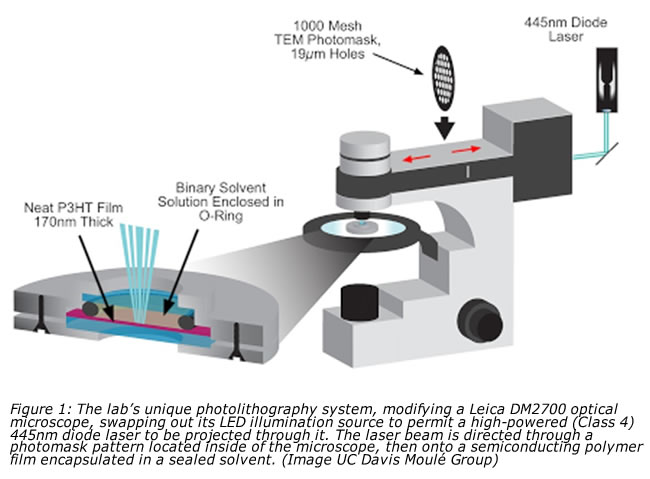 |
Full article...
|
|
MK52 Optical Table &
Workstation
Ergonomically Designed Ultra-Low
Frequency Vibration Isolation
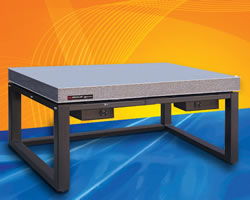 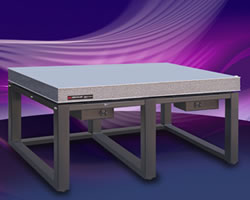
The
MK52:Series Vibration
Control Optical Table with more ergonomic comfort is designed specifically for
ultra-low natural frequency applications. The system utilizes Minus K's
patented negative stiffness vibration isolators to provide a compact, passive
optical table with ultra-low natural frequencies, higher internal structural
frequencies, and excellent vertical and horizontal isolation efficiencies.
- Ultra-Low Natural Frequencies
- Vibradamped Frame
- Customizable Accessories
- No Air Supply Needed - Easy to Use
- Choice of Tabletops
- Ergonomic Styling
More...
Pricing & sizes for
MK52
|
For decades, pneumatic air tables have been
the workhorse for reducing vibrations in cleanrooms for manufacturing and
research, where critical micro-engineering instrumentation is employed. But
just as technology has steadily pushed the boundaries into nano-applications in
microelectronics fabrication, industrial laser/optical systems and biological
research, so has the need become ever more necessary for improved precision in
vibration isolation.
Increasingly, pneumatic air tables are taking a
back seat to the more recent technology of negative-stiffness vibration
isolation, which over the past 20 years since its introduction, has proven
itself in thousands of applications throughout industry, government and
academia, including some of the most diverse and challenging environments, such
as cleanrooms.
Vibration Sources
Vibration can
be caused by a multitude of factors. Every structure is transmitting noise.
Within the building itself, the heating and ventilation system, fans, pumps and
elevators are just some of the mechanical devices that create vibration.
Depending on how far away the cleanroom equipment is from these vibration
sources, and where in the structure the equipment is located, whether on the
third floor or in the basement, for example, will determine how strongly the
equipment will be influenced. External to the building, the equipment can be
influenced by vibrations from adjacent road traffic, nearby construction, loud
noise from aircraft, and even wind and other weather conditions that can cause
movement of the structure.
Vibrations in the range of 2 hertz (Hz) to
20,000 Hz will influence sensitive equipment. But these internal and external
influences primarily cause lower frequency vibrations, which are transmitted
through the structure, creating strong disturbances in precision equipment used
in cleanrooms.
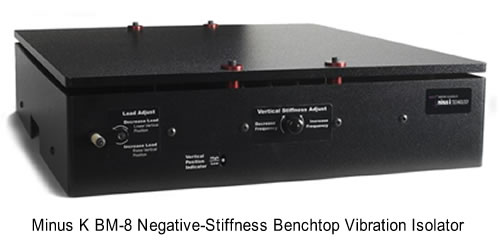
Vibration Isolation
Used
extensively in semiconductor manufacturing, biotechnology, the life sciences,
and other fields that are very sensitive to environmental contaminants - such
as dust, airborne microbes, aerosol particles, and chemical vapours -
cleanrooms provide an enclosed environment with a controlled level of
contamination that is specified by the number of particles per cubic metre at a
specified particle size.
Equipment employed inside the cleanroom must be
designed to generate minimal air contamination including vibration isolation
equipment, which can range from relatively simple rubber blocks, metal springs
and breadboards, to highly efficient air systems, active electronic systems,
and negative-stiffness systems - constructed with more advanced technologies
and materials for higher precision vibration isolation.
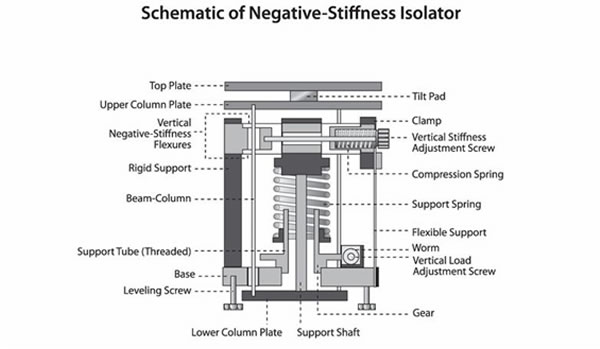
Full article...
|
|
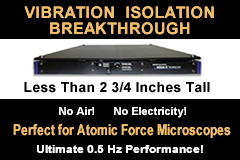
Press Release
New
Ultra-Thin
CT-2 Low-Frequency
Vibration Isolation Platform Adapts to Space Constraints in Critical Micro- and
Nano-Microscopy
Press
Release: Minus K Technology has announced the new ultra-thin, low-height
model
CT-2 passive isolator -
the successor to the
CT-1 offers better
horizontal performance with additional payload ranges for heavier instruments.
The completely passive tabletop unit is just under 2-3/4 inches in height, yet
delivers 1/2 Hz vertical natural frequency, and ~1-1/2 Hz horizontal natural
frequencies - considerably more low-frequency vibration isolation performance
compared to air tables and active systems. The
CT-2 utilizes Minus K's
breakthrough patented technology that led to a Laser Focus
World 2019 Innovation
Award

The new Negative-Stiffness
CT-2 ultra-thin,
low-height, low-frequency vibration isolation platform mitigates space
constraints in microscopy applications.

Full
release...
# # # |
 |
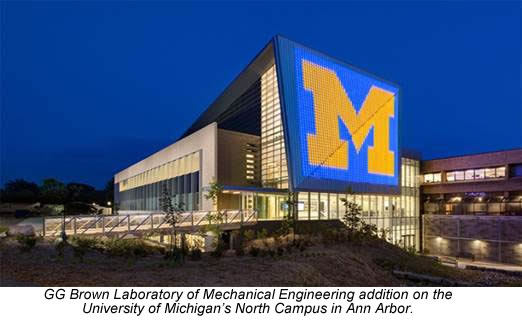 |
The Ultra-Low Vibration Lab (ULVL) is a
part of the new Center of Excellence in Nano Mechanical Science and Engineering
(NAMSE) – a recent addition to the G.G. Brown Laboratories on the North
Campus of the University of Michigan in Ann Arbor. Noel Perkins, former
associate chair for Facilities and Planning with the Department of Mechanical
Engineering, describes this addition as a
“building-within-a-building”. The Nanoengineering Lab, located
on the ground floor, contains eight ultra-low-vibration chambers for
nanoscale metrology, mechanical, temperature and interference
testing.
The chambers are structurally isolated from the balance of the
building. Vibration isolation tables are mounted on pillars that are part of an
8-ft-thick seismic mass, which is isolated from the chamber floors. Even
researchers footsteps wont disturb experiments. With the emergence of
nanotechnology and nanoengineering of the last two decades, a relatively small
number of institutions and agencies have been able to construct facilities for
ultra-sensitive measurements, and I know of none that are focused on the
mission of a mechanical engineering department, said Edgar Meyhofer, professor
of mechanical engineering and biomedical engineering at the
university.
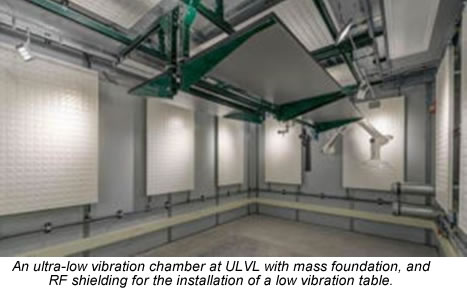
Validating Fluctuational
Electrodynamics
When heat travels between two separated objects, it
flows differently at the smallest scales distances on the order of the diameter
of DNA, or 1/50,000 of a human hair. For example, heat radiates 10,000 times
faster at the nanoscale. Researchers have been aware of this for decades, but
they have not understood the process. Now, at ULVL, researchers have measured
how heat radiates from one surface to another in a vacuum at distances down to
2 nanometers. "We've shown for the first time, the dramatic enhancements of
radiative heat fluxes in the extreme near-field," said Reddy. "Our experiments
and calculations imply that heat flows several orders of magnitude faster in
these ultra-small gaps." Reddy and Meyhofer led the work. A paper on the
findings was recently published in the international journal of science,
Nature.
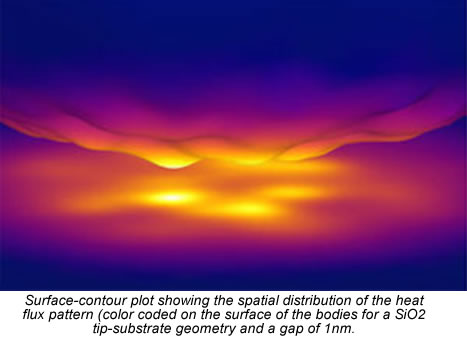
Full article...
|
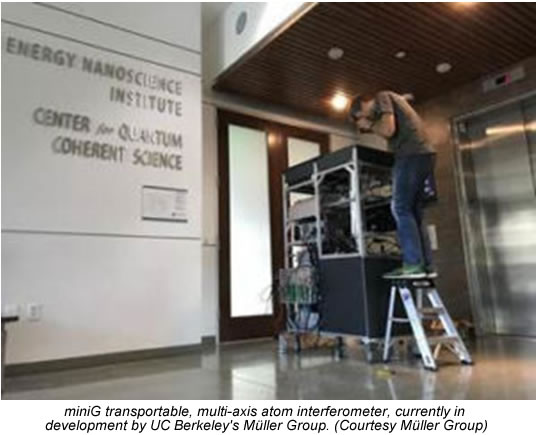 |
|
Professor Holger Müller's Group at UC
Berkeley is focused on advancing experimental quantum technology to push the
sensitivity of experiments to new levels, and to perform precision measurements
of fundamental constants. The groups work uses methods from atomic, molecular
and optical physics. One project is the development of a transportable,
multi-axis atom interferometer, named miniG.
MiniG was designed to
research how quantum interference can be used to measure gravity outside of the
laboratory. When cooled to just above absolute zero, the atoms form the focus
of a portable quantum gravimeter.
Gravimeters, used to measure
gravitational acceleration, have been successfully applied for metrology,
geology and geophysics. MiniG uses an atom interferometer to measure the effect
of gravity on clouds of atoms that are first trapped and cooled. Interferometry
inherently depends on the wave nature of the object. Particles, including
atoms, can behave like waves. Atom interferometers measure the difference in
phase between atomic matter waves along different paths.
We use atoms
that are laser-cooled to millionths of a degree above absolute zero, said
Xuejian Wu, a post-doctoral scholar, involved in the development of miniG at
the Müller Group. With pulses of light, we drive each atom into a quantum
superposition of having been kicked with the momentum of photons, or not
kicked. The atoms, in two places at one time, are in a superposition of
recoiling backwards or staying still. By manipulating the state of the atoms
using one of two types of such light pulses, we steer the matter waves' paths
and recombine the matter waves at the end of the experiment.
Atom
interferometry has become one of the most powerful technologies for precision
measurements, and atomic gravimeters, based on atom interferometry, are
extremely accurate and have long-term stability.
Current atom
interferometers, however, are too complicated to operate in a miniature package
or under field conditions. Berkeleys mini-G was engineered to resolve this
issue.
In this project, we are developing a mobile atom interferometer
using a single-diode laser system and a pyramidal magneto-optical trap,
continued Wu. This allows the device to be smaller, simpler and more robust
than conventional atom interferometers.
Vibration
Isolation
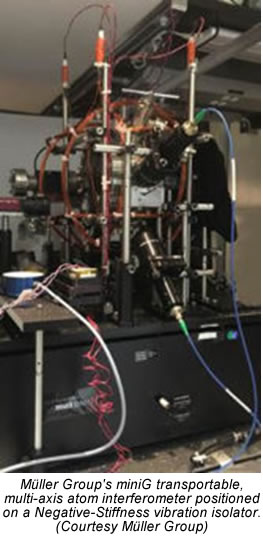
Measurements of atomic precision require
isolation from ambient vibrations coming from internal and external sources. As
measurements are being done at a smaller and smaller level, those vibrations
that are present will start to dominate, and the need for more effective
isolation increases.
Although the Müller Groups research
laboratory is situated in the basement of a building on the Berkeley campus, it
is still influenced by vibrations from the buildings HVAC system.
For
several years now we have been using
Negative-Stiffness vibration isolation for our
research projects, continued Wu.
Full article...
|
 |
|
The United States Bowling Congress
(USBC) is the national governing body of bowling, as recognized by the United
States Olympic Committee. It is a membership organization that provides
standardized rules, regulations and benefits for certified bowling leagues and
tournaments. The USBC is one of the worlds largest sports and recreation
membership organizations, in the United States serving approximately 1.4
million bowlers that participate in USBC-certified leagues and tournaments on
both the national and local levels.
Critical to the initiatives of the
USBC is its Department of Equipment Specifications and Certification, which
encompasses testing and research of bowling equipment to set standards and
enhance the sports credibility.
“There are two sides to bowling
– the recreational, and the more competitive,” said Tom Frenzel,
Research Engineer with the USBC. “Our focus is on research, testing,
standardization and certification of bowling equipment used for leagues and
tournaments.”
“Basically, any piece of equipment that
touches the bowling lane comes though this department to be evaluated, and
determined whether or not it should be allowed to be used,” added Frenzel.
“This includes bowling pins, bowling balls, lane panels, lane
conditioners, gutters, and kick-back walls in the pin deck.”
To this end, the department uses a number of research and testing
methodologies to ensure that not only do these products meet established
specifications, but that they are manufactured to within a 4 Sigma quality
manufacturing limit, which means within a 0.6 percent defect rate. Essentially,
ensuring that 99.4 percent of all bowling products used for certified leagues
and tournaments are within designated specifications.
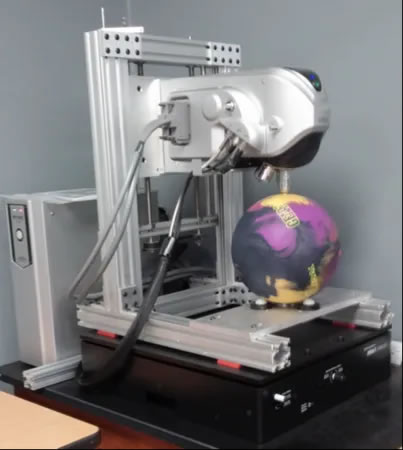
Minus K
Negative-Stiffness vibration isolator,
under a 3D laser-scanning, digital
confocal microscope.
Surface Roughness of Bowling
Balls
One area of ongoing research and testing at USBC concerns surface
roughness of bowling balls.
Since the early 1990s, better bowling ball
coverstocks have been developed. These coverstocks find more friction on the
lane, and inevitably hook more. They also disrupt the oil pattern on the lane
more, which tends to reduce friction. So the USBC engineering team is trying to
better understand the implications of these factors, and better control their
outcomes.
It has become popular to sand bowling balls with different
grits of sand paper, explained Frenzel. This practice has helped us see how the
sanding level on a ball affects its surface layer, then we compare this back to
how it performs on the lane.
The rougher you get the ball, the more the
ball will hook, and the more friction it will find, continued Frenzel. The
friction will define how the ball accelerates. So more friction means more
acceleration, which just means it is changing its speed quicker, or in less
time. It is really hooking sooner versus later, or taking less time to
hook.
Full article...
|
|
(2007 legacy article) - Whether it's an NMR
or a two-photon microscope, scientists love toys - at least when they work.
Sometimes the most mundane things bungle technology: environmental
vibrations from cars driving by, central air conditioning, the voices of the
operators, and even the ocean. As instruments become more sensitive,
subsonic rumblings become more insidious, particularly for nano-technology
applications. With many instruments, such as atomic-force and electron
microscopes, cutting down on vibration is essential to collecting good data.
"You could spend a million or two million on a microscope and have it rendered
useless because of vibration," says Kurt Alberline, an anatomist at the
University of Utah School of Medicine, who runs an electron microscopy
lab.
When researchers suspect vibration is wreaking havoc on their data,
they should identify the origin of the noise or get an environmental engineer
to find it, say scientists who regularly deal with vibration. For example,
Vicki Colvin, a chemist at Rice University in Houston, noticed images moving
around in a circle on her transitional electron microscope. "It was like a
ghost," she says. Colvin discovered that an air duct was causing the problem
and spent $1.20 on a shield to divert air away from the scope. "The easiest way
to get rid of vibrational noise is to stop it at its source." says Larry Cohen,
a neuroscientist at Yale University.
The design of a building is
critical to the vibration that reaches an instrument, says Ahmad Soueid, senior
vice president at HDR Architecture in Omaha, Neb., which has designed more than
a dozen nanotech laboratories. Isolating air-handling equipment from
laboratories and using special joints that redirect vibration to the ground are
some of the fixes his firm uses. Recently, concerns over vibration plagued a
$250 million NIH facility under construction in Baltimore. Initial reports
indicated the building's quivers could render confocal microscopes useless,
although later measurements suggested most instruments will work with proper
dampening
There's no universal fix, says David Platus, president of
Minus K, a company that makes high-end vibration-isolation tables. Solutions
vary, from cheap rubber pads that rest under instruments, to the air-cushioned
tables that have been around for 50 years, to tables that sense vibration and
cancel it out. "The more sensitive the instrument, the better isolation you
need." he says.
Full article...
Example Causes of Bad
Vibrations:
Automotive
Buildings
Columns
Computers
Elevators
Engines/Motors
Floors
Freeway & Road Traffic
Generators
HVAC (Heating & Air Conditioning Issues)
Machinery
Mechanical Entities
Plumbing, Piping
Pneumatic factors
Seismic Waves
(including from ocean waves)
Trains & Subways
Transformers
Winds
Against Buildings
(Examples with
Hz...)
|
|
Vibration Isolation for Heavy
Payload Systems
Minus K vibration isolation systems can be
designed for very heavy payloads. The following are some typical isolator
dimensions. The 10,000 lb and 25,000 lb isolator dimensions are approximate and
are based on preliminary designs.
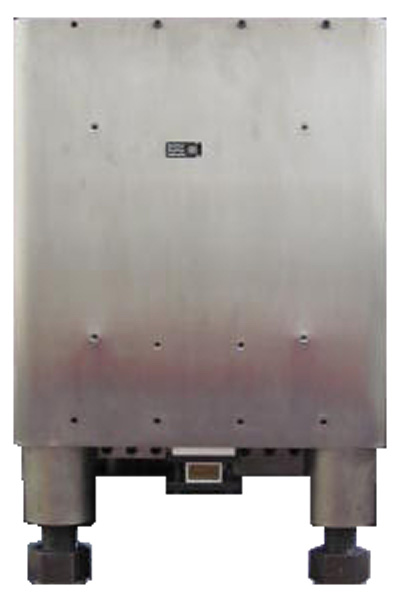
XM-1:
10,000 lb capacity: 20"W x 20"D x 22"H
The James Webb Space Telescope is the largest
cryogenic instrument telescope to be developed for space flight. It is a
large-aperture infrared space telescope and the scientific successor to NASA's
Hubble Space Telescope and used a set of six custom heavy capacity Minus K
vibration isolators for ground testing.
The ground testing confirmed
the telescope and science instrument systems will perform properly together in
the cold temperatures of space. Additional test support equipment including
mass spectrometers, infrared cameras and television cameras were also supported
by Minus Ks heavy capacity vibration isolators which allowed engineers to
observe the testing.
Each of the isolators was designed for 10,000 lbs.
and the total payload supported from the top of the Johnson Space Center vacuum
Chamber A was 60,000 lbs.
The isolators allowed NASA to simulate the
telescopes performance in space while preventing all the ground-based
disturbances, such as the pumps and motors, and even traffic driving by from
interfering with the ground testing.
Case study:
NASA James Webb Space Telescope
(JWST).
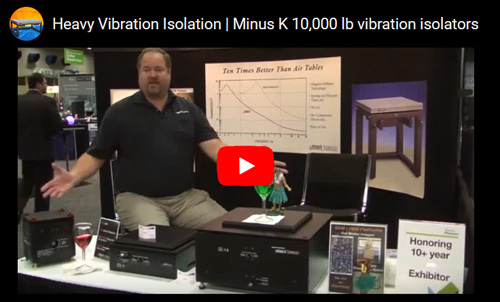
|
Previous
Features:
Vibration
Criterion (VC) Curves-Lab Analysis

Press Release: Laser Focus World Innovator Award
for
Ultra-Thin, Low-Height CT-1
How They
Work>>Negative-Stiffness Vibration Isolators
Microscopy Vibration
Isolation
FAQs>>Frequently Asked
Questions About Vibration Isolation
Custom Vibration Isolation
Systems
Audio Reproduction & Turntable
Vibration Isolation
Vibration Isolator Steadies Optics
for NASA Telescopes + Vacuum Isolation
Optical-Laser Vibration Isolation +
video
Optical-Laser Vibration Isolation +
video
Cryostat Vibration
Isolation
Nanoindentation & Micro Hardness
Testing
Vibration Isolation
Ultra-Low Frequency Vibration
Isolation Stabilizes Scanning Tunneling Microscopy
Neuronal Research into Animal
Learning, Memory Neuronal Research,
Vibration Isolation Problem &
Solution
Sunken Treasure Surrounding The
Coldest Cubic Meter In The Universe
Supported by Minus K Vibration
Isolators
Lithium Batteries: Superionic Solid
Electrolytes for Next-Generation
Spacecraft Vibration Isolation On the
Ground
Behavior of a Single Molecule-UCLA's
California NanoSystems Institute
Cleanroom Precision Vibration
Isolation
Negative-stiffness vibration
isolation is utilized to provide ultra-stability for multi-disciplined,
nano-level research at UCLA's California NanoSystems
Institute.
NASA/JWST Update: Custom James Webb
Space Telescope Vibration Isolators Working Well
Audiophile Interests: The Doehmann
Helix 1 Turntable
Minus K Technology Educational
Giveaway to U.S. Colleges and Universities
Articles In The
News
|
|

 |
|
|
